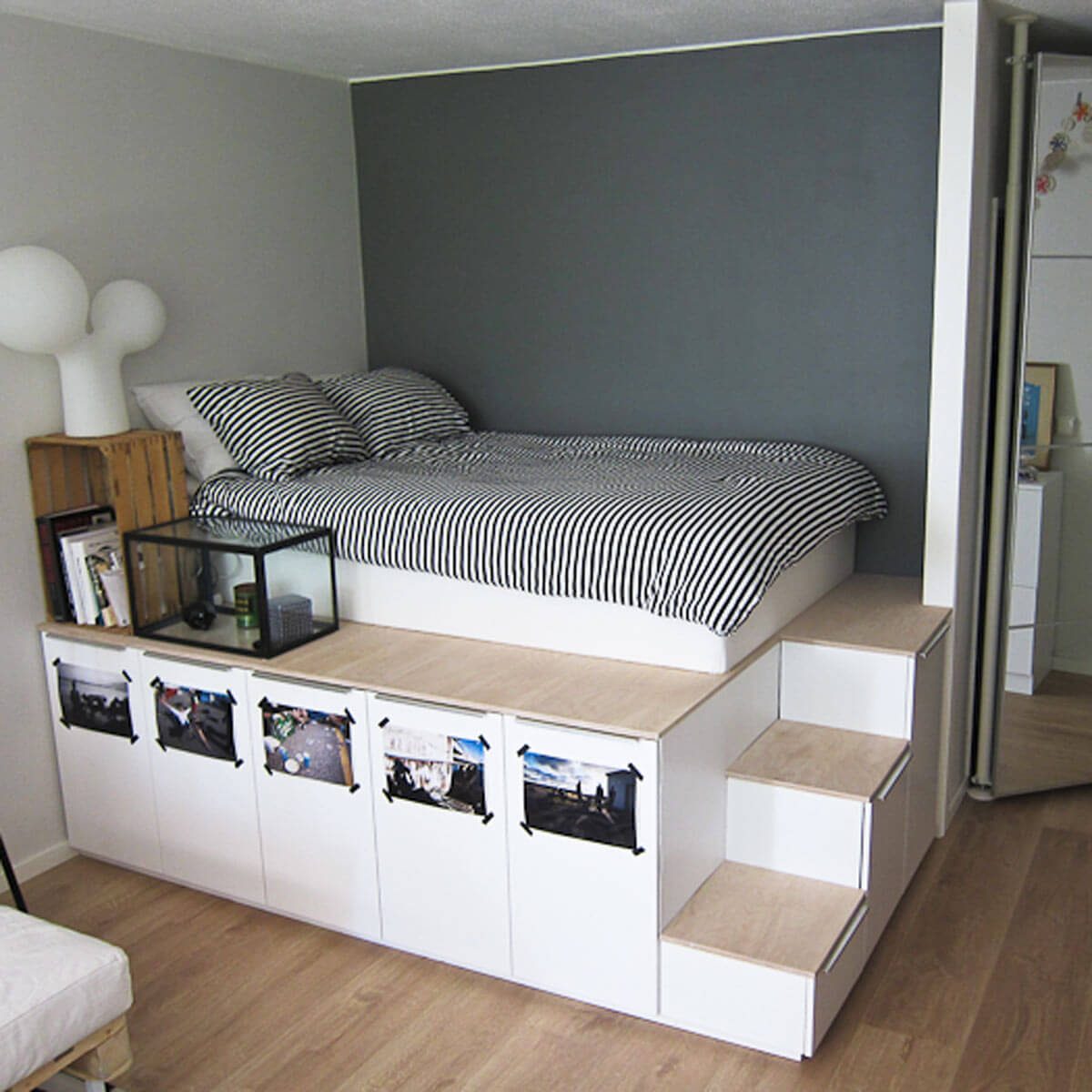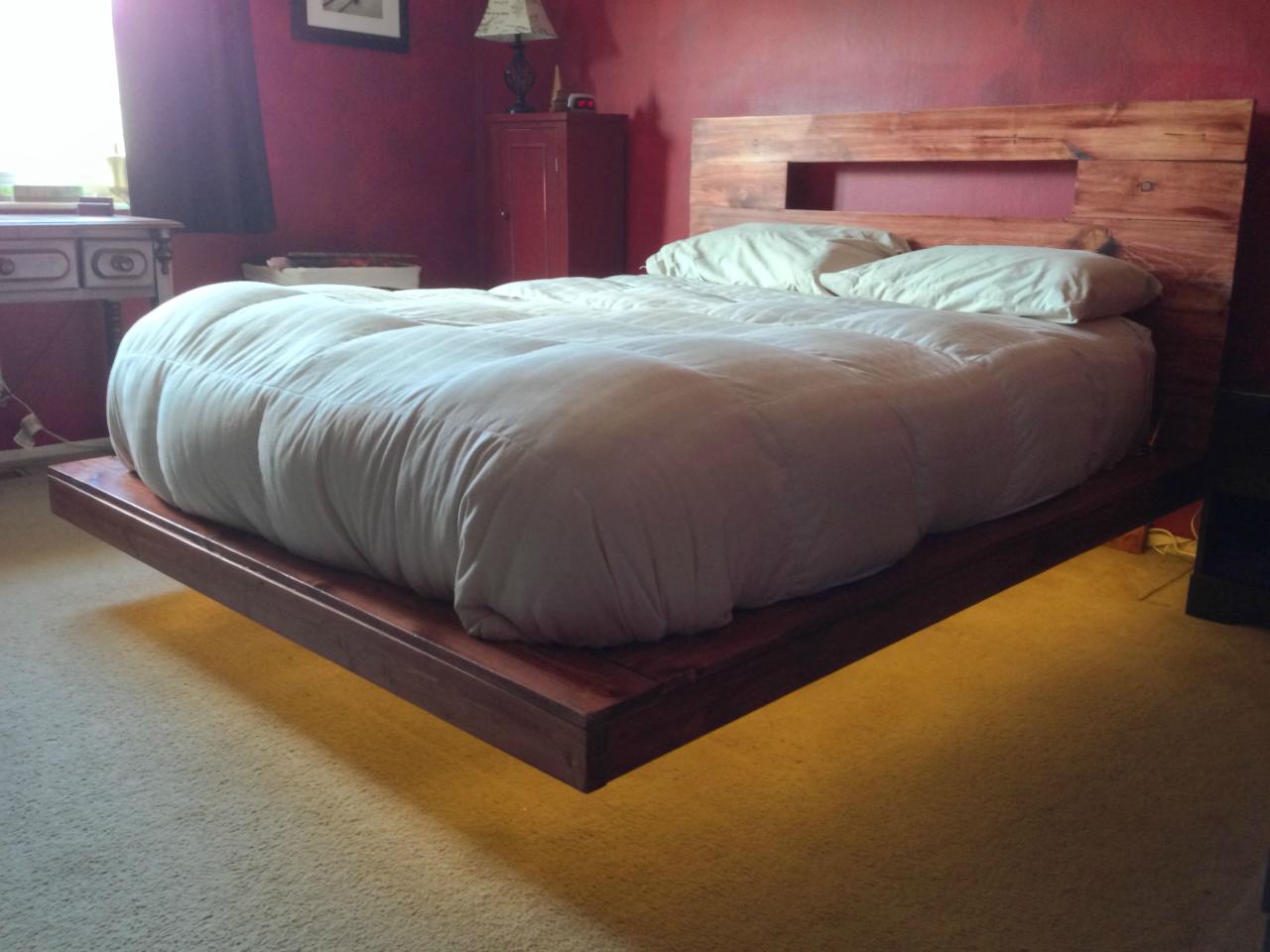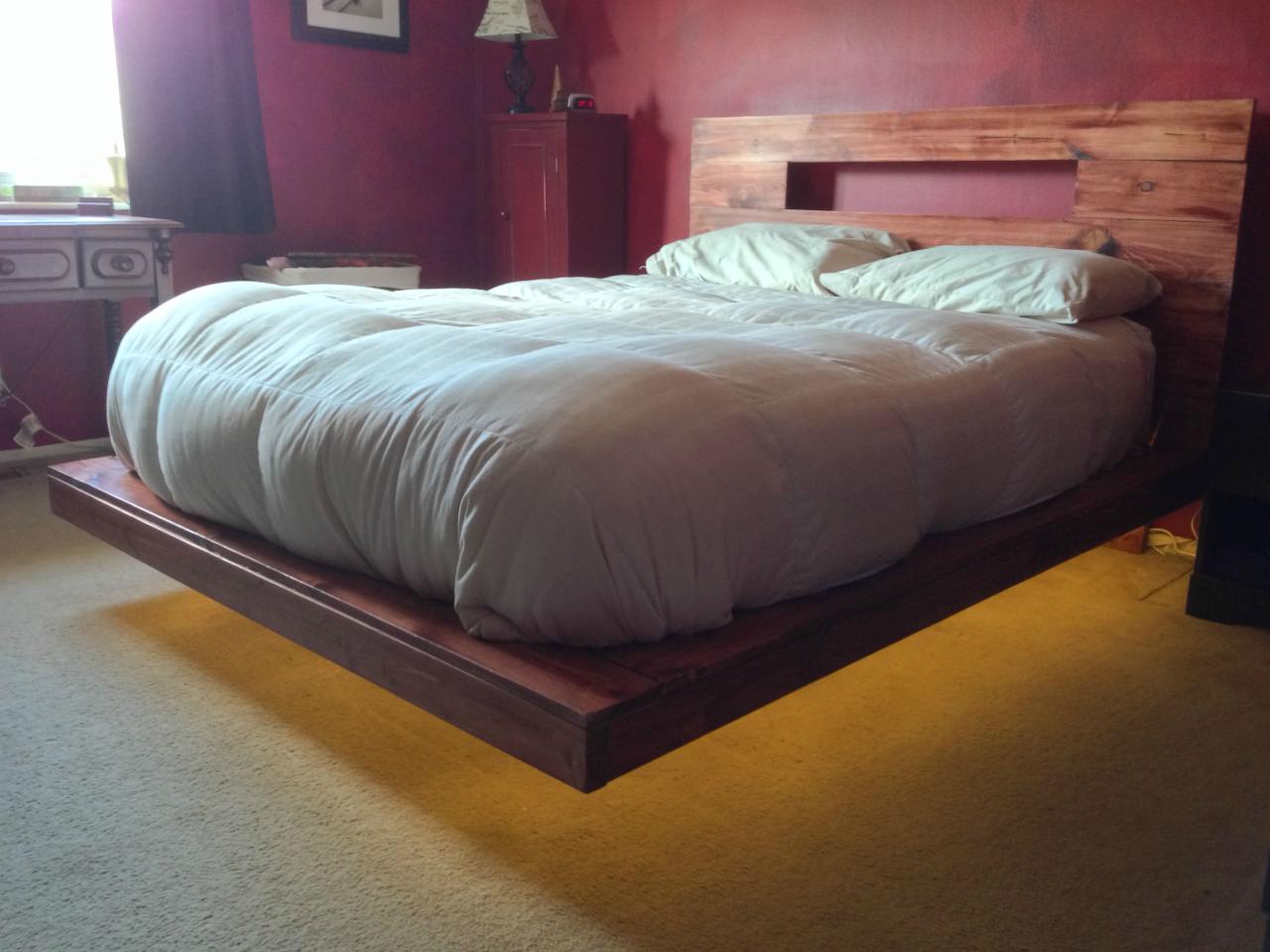DIY bed frame: Tired of generic, cookie-cutter furniture? Craving a bed that reflects your unique style and fits your space perfectly? Building your own bed frame is a rewarding project that empowers you to create a truly personalized sleep haven. Not only will you save money, but you’ll also gain a sense of accomplishment and a piece of furniture that is uniquely yours.
From simple platform frames to elaborate headboards, the world of DIY bed frames is vast and exciting. Whether you’re a seasoned woodworker or a beginner, there’s a project out there that suits your skill level and budget. This guide will walk you through every step of the process, from planning and design to construction and finishing touches. Get ready to unleash your creativity and build the bed of your dreams.
Introduction to DIY Bed Frames
Building a DIY bed frame can be a rewarding and cost-effective way to create a unique and personalized sleeping space. Not only can you save money, but you also have the freedom to customize your bed frame to your exact specifications and preferences.
This guide will explore the benefits of building a DIY bed frame, provide examples of different types of DIY bed frames, and explain why people choose to build their own beds rather than purchasing them from a store.
Benefits of Building a DIY Bed Frame
Building a DIY bed frame offers numerous benefits, including:
- Cost Savings: DIY bed frames can significantly reduce your overall bed-buying costs. You can save money by sourcing materials yourself and avoiding the markup often found on store-bought bed frames.
- Customization: DIY allows you to create a bed frame that perfectly fits your needs and style. You can choose the size, materials, and design to match your bedroom décor and personal preferences.
- Unique Design: Building your own bed frame allows you to create a truly unique piece of furniture that reflects your personality and style. You can incorporate unique features, materials, and finishes that are not readily available in stores.
- Increased Satisfaction: The process of building a DIY bed frame can be a rewarding experience, providing a sense of accomplishment and satisfaction. You can enjoy the creative process and take pride in building something with your own hands.
Types of DIY Bed Frames
There are many different types of DIY bed frames you can build, each with its own unique design and construction techniques. Here are a few popular examples:
- Platform Bed Frame: Platform bed frames are simple to build and require minimal tools. They typically consist of a wooden frame supported by slats or a solid platform, providing a sturdy base for your mattress.
- Headboard Bed Frame: Headboard bed frames offer a more traditional and elegant look. They include a headboard, often made of wood or upholstered, which provides support and a decorative element. You can choose from various headboard styles, including slatted, tufted, or curved.
- Sleigh Bed Frame: Sleigh bed frames are characterized by their distinctive curved headboard and footboard, creating a grand and luxurious feel. They are often made of wood and can be ornate or minimalist in design.
- Canopy Bed Frame: Canopy bed frames feature a draped fabric canopy that adds a touch of romance and privacy to your bedroom. The canopy can be attached to the headboard or supported by a separate frame, allowing for customization in terms of style and fabric choice.
Reasons for Choosing DIY Bed Frames
Many people choose to build their own bed frames for a variety of reasons, including:
- Cost-Effectiveness: As mentioned earlier, DIY bed frames can significantly reduce costs compared to store-bought options.
- Customization: DIY allows for complete customization, ensuring the bed frame perfectly matches your preferences and needs.
- Unique Design: Building your own bed frame allows you to create a unique and personalized piece of furniture that reflects your style.
- Sense of Accomplishment: The process of building a DIY bed frame can be rewarding and fulfilling, providing a sense of pride and accomplishment.
Choosing Materials

The materials you choose for your DIY bed frame will significantly impact its durability, aesthetics, and overall cost. Carefully considering your needs and budget will help you make the best choice.
Wood Types
Wood is a popular choice for bed frames due to its natural beauty, strength, and versatility. Here are some commonly used wood types:
- Pine: Affordable, lightweight, and easy to work with. Pine is a good option for beginners, but it’s softer and more prone to scratches and dents.
- Oak: Strong, durable, and aesthetically pleasing. Oak is a classic choice for bed frames and can withstand heavy use.
- Maple: Hard, dense, and known for its beautiful grain patterns. Maple is a more expensive option but provides excellent durability.
- Cherry: Durable and with a rich reddish-brown hue. Cherry is a popular choice for high-end furniture.
- Walnut: Known for its dark, rich color and distinctive grain patterns. Walnut is a premium wood option.
Metal
Metal bed frames offer durability, stability, and modern aesthetics. Here are some popular metal options:
- Steel: Strong, durable, and affordable. Steel is a good option for simple, modern bed frames.
- Iron: Offers a classic, elegant look. Iron can be more expensive than steel but is often used for ornate designs.
- Aluminum: Lightweight, corrosion-resistant, and often used for contemporary bed frames. Aluminum can be more expensive than steel or iron.
Sustainable and Eco-Friendly Materials
Choosing sustainable materials for your bed frame is a responsible choice for the environment.
- Reclaimed wood: Repurposing old wood reduces waste and adds character to your bed frame.
- Bamboo: A fast-growing and renewable resource that’s strong and durable.
- Recycled metal: Using recycled metal reduces the demand for new resources and lowers your carbon footprint.
Construction Techniques: Diy Bed Frame
Building a bed frame is a rewarding DIY project that allows you to create a unique piece of furniture that perfectly complements your bedroom. This section will guide you through the essential construction techniques, offering practical tips and tricks for building a sturdy and stylish bed frame.
Basic Bed Frame Construction
Constructing a basic bed frame involves a series of steps that ensure stability and support for your mattress. Here’s a breakdown of the typical process:
- Cut the wood: Begin by carefully measuring and cutting the wood pieces for the bed frame using a saw. Ensure all cuts are accurate and square for a stable structure.
- Assemble the headboard and footboard: Join the headboard and footboard pieces using wood glue and screws. For added strength, consider using pocket holes or mortise and tenon joints.
- Construct the side rails: Cut and join the side rails, ensuring they are the correct length to accommodate your mattress. These rails will connect the headboard and footboard, forming the main structure of the bed frame.
- Attach the slats: Install slats across the frame to support the mattress. Slats can be made from wood or metal, and they should be spaced appropriately to provide adequate support.
- Finish the frame: Sand the bed frame to smooth out any rough edges and apply a stain or paint to achieve your desired finish.
Creating Different Bed Frame Styles, Diy bed frame
The beauty of DIY bed frames lies in the ability to personalize their design. Here are some popular bed frame styles and techniques:
- Platform bed: A platform bed frame features a solid base without a box spring. You can create a platform bed by attaching plywood or slats directly to the frame.
- Sleigh bed: A sleigh bed is characterized by its curved headboard and footboard. To achieve this style, you can use a router to create the curves or purchase pre-shaped wood pieces.
- Canopy bed: A canopy bed offers a dramatic and elegant look. You can create a canopy by attaching posts to the headboard and footboard, and then draping fabric over the posts.
- Headboard-only bed: A headboard-only bed frame is a minimalist option that allows you to use a box spring and mattress without a full frame. You can create a headboard-only bed by simply building a headboard and attaching it to the wall.
Achieving a Professional Finish
With a little attention to detail, you can achieve a professional finish on your DIY bed frame:
- Use high-quality materials: Investing in high-quality wood and hardware will ensure your bed frame is durable and long-lasting.
- Precise measurements and cuts: Accurate measurements and cuts are essential for a stable and visually appealing bed frame.
- Sanding and finishing: Proper sanding and finishing techniques will enhance the appearance and protect the wood.
- Hardware and fasteners: Use high-quality screws, bolts, and other hardware to ensure the bed frame is securely assembled.
- Consider pre-made components: If you’re not comfortable with woodworking, you can use pre-made components, such as headboard and footboard kits, to simplify the construction process.
Adding Features
A DIY bed frame is a blank canvas for creativity. You can go beyond the basics and incorporate features that enhance functionality, style, and personal touch.
Storage Solutions
Storage solutions can be a game-changer, especially in smaller bedrooms. Here are some ideas:
- Under-bed Drawers: Build drawers that slide out smoothly from the frame’s base. Consider using plywood or MDF for the drawer boxes and sturdy drawer slides for smooth operation.
- Hidden Compartments: Create hidden compartments within the headboard or footboard. This can be a great way to store books, blankets, or other items. Consider using hinges and a simple latch for access.
- Open Shelves: Add open shelves to the sides of the bed frame for easy access to items like books, plants, or decorative objects.
Headboard and Footboard Design
The headboard and footboard offer opportunities to showcase your design skills and add a unique touch.
- Upholstered Headboard: Choose a comfortable fabric and padding for a luxurious look and feel. Consider using foam padding and fabric upholstery staples for a professional finish.
- Floating Headboard: A floating headboard appears to be suspended above the bed, creating a modern and minimalist aesthetic. It can be made from wood or even metal, and it can be attached to the wall or the bed frame itself.
- Built-in Nightstands: Integrate nightstands into the headboard or footboard, maximizing space and creating a cohesive look.
Lighting Integration
Lighting can transform the ambiance of your bedroom and make it more functional.
- Under-bed Lighting: Install LED strip lights under the bed frame to create a soft glow or mood lighting. Use adhesive strips for easy installation.
- Headboard Lighting: Incorporate LED lights into the headboard for reading lights or accent lighting. Consider using a dimmer switch for adjustable brightness.
- Built-in Outlets: Integrate electrical outlets into the headboard or footboard for convenient access to charging devices.
Budgeting and Cost Considerations

A DIY bed frame project can be a budget-friendly way to get a new bed, but it’s important to plan your finances carefully. Here’s how to determine the cost of your project and make the most of your budget.
Creating a Budget Breakdown
A comprehensive budget breakdown is crucial for staying on track. Here’s a typical cost breakdown for a DIY bed frame:
- Materials: This is the largest expense. Consider the cost of wood, hardware, fasteners, paint, stain, and any other decorative elements you plan to use.
- Tools: If you don’t already own them, you’ll need to purchase tools like a saw, drill, screwdriver, level, tape measure, and sander.
- Optional Extras: These might include headboard and footboard fabric, mattress support slats, storage drawers, or lighting.
For example, a basic queen-sized bed frame made from pine lumber could cost around $100-$150 for materials, while a more elaborate frame with additional features could cost upwards of $300.
Building a DIY bed frame can be a rewarding project, allowing you to customize your bedroom to your liking. Similar to the satisfaction of constructing a DIY chicken coop for your feathered friends, creating a bed frame from scratch provides a sense of accomplishment.
Once complete, you’ll have a unique piece of furniture that reflects your personal style and enhances your sleep sanctuary.
Comparing DIY Costs to Store-Bought Options
DIY bed frames often offer significant cost savings compared to store-bought alternatives. For instance, a basic queen-sized bed frame from a furniture store could cost $300-$500, while a comparable DIY frame might cost half as much.
Saving Money on Materials and Tools
Here are some strategies for reducing your DIY bed frame expenses:
- Shop Around for the Best Prices: Compare prices at different lumber yards, hardware stores, and online retailers.
- Consider Recycled Materials: Look for reclaimed wood or repurposed materials like pallets or old furniture.
- Purchase Tools in Bulk: If you plan to do more DIY projects, buying tools in bulk can often save you money in the long run.
- Borrow Tools: Consider borrowing tools from friends, family, or a local library.
- Look for Sales and Discounts: Many retailers offer sales and discounts on lumber and hardware, so be sure to check for these before making your purchases.
Beyond the Basics
Once you’ve mastered the fundamentals of DIY bed frame construction, you might be eager to explore more advanced techniques and creative possibilities. This section delves into building complex bed frames, incorporating custom features, and accessing resources for further inspiration.
Advanced Construction Techniques
Advanced construction techniques allow you to create more intricate and unique bed frames.
- Mitered Joints: These joints create a visually appealing, clean finish by joining two pieces of wood at a 45-degree angle. Mitered joints are often used for creating decorative elements like headboards or footboards.
- Mortise and Tenon Joints: This traditional joinery method involves cutting a rectangular hole (mortise) in one piece of wood and a corresponding projection (tenon) on another. Mortise and tenon joints are extremely strong and durable, making them suitable for heavy-duty furniture pieces like bed frames.
- Dovetail Joints: Dovetail joints are another classic joinery technique that involves interlocking pieces of wood with a dovetail shape. This creates a strong, visually appealing joint that is particularly useful for drawers or other components that require precise alignment.
Incorporating Custom Features
Adding custom features to your bed frame can enhance its functionality, style, and personal touch.
- Built-in Storage: Create drawers, shelves, or cubbies within the frame to maximize storage space and keep your bedroom organized. You can design these storage solutions to suit your specific needs and preferences.
- Headboard Designs: Explore various headboard designs, from simple and minimalist to ornate and elaborate. You can use different materials like wood, metal, or fabric to create a headboard that complements your overall bedroom style.
- Lighting Integration: Incorporate lighting elements into your bed frame, such as built-in reading lights or accent lighting. This can add a touch of ambiance and practicality to your bedroom.
Resources for Further Learning and Inspiration
Many resources are available to help you learn more about advanced bed frame construction and find inspiration for your own designs.
- Online Tutorials and Videos: Platforms like YouTube, Skillshare, and Instructables offer a wealth of DIY bed frame tutorials and videos, covering various techniques and designs.
- Books and Magazines: Explore woodworking books and magazines for detailed instructions, project plans, and design inspiration. These resources often feature step-by-step guides and professional tips.
- Online Communities: Join online forums and communities dedicated to woodworking and DIY projects. These platforms offer opportunities to connect with other enthusiasts, share ideas, and seek advice.
Last Recap
Creating a DIY bed frame is a journey that blends creativity, skill, and personal touch. From the initial planning to the final finishing touches, each step allows you to express your individual style and build a piece of furniture that truly reflects you. So, embrace the challenge, gather your tools, and embark on this rewarding project. You’ll be amazed at what you can achieve, and your bedroom will thank you for it!
